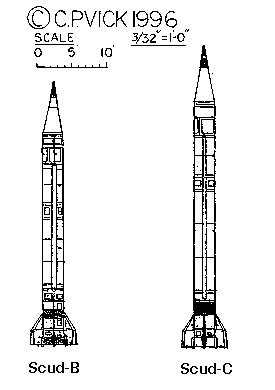رد: مصر تسرع وتيره تطوير صواريخها البعيده المدى
Missile cooperation in the 1980s
It was in the 1980s that Egypt began its first successful drive for missile production capability. Argentina, Iraq and North Korea were all recruited as helpers. Egypt's first step was to ship at least two of its Soviet-supplied Scuds to North Korea for reverse-engineering. In return for the missiles, Pyongyang agreed to help Cairo build Scuds on its own. North Korea provided technical documents, drawings and extensive access to North Korea's own Scud production program.
At the same time it was working with North Korea, Egypt began a secret project with Argentina and Iraq to build a 1,000km-range missile known as the Condor-II in Argentina and the Badr-2000 in Egypt. "The goal was to develop a missile in Argentina and then pass the cookbook to Egypt and Iraq," says a knowledgeable U.S. official. The project began in 1982, with Egypt promising to help Argentina with technology and with Iraq paying the bills. The Condor-II/Badr-2000 was a solid-fuel, two-stage missile designed to fly 800-1,200 kilometers with a 500-kilogram payload.
Work on the Condor-II began at a site near Falda del Carmen in Argentina's Sierra Chica mountains. Similar sites were later built in Egypt and Iraq. The Egyptian site reportedly included a missile fuel and test area at Abu Zaabal and a missile production facility at Helwan. Argentina, Egypt and Iraq procured the necessary technologies from a number of Western armament and aerospace companies, primarily in Germany and Italy. The leading supplier was Germany's Messerschmitt-Boelkow-Blohm (MBB), which had designed the missile's Argentine predecessor, the Condor-I.
Due to the sensitivity of the project, its suppliers sought to conceal their participation after 1985. To accomplish this, work on the Condor-II was taken over by a consortium of companies known as "Consen," including some of Europe's defense industry giants. The whole operation was headquartered in Munich and used foreign subsidiaries. Press reports have linked several supplier firms to the project, including SNIA-BPD, a subsidiary of Italy's Fiat; Transtechnica, a subsidiary of MBB; the French company Sagem; and the German firm MAN. Nearly 20 others were reported to have played a role in procuring technologies for the Condor, including companies named Delta Consult, Ifat, Desintec, Condor Projeckt and Aerotec.
In addition to procuring technology in Europe, Egypt went shopping for controlled goods in the United States. A California rocket scientist, Egyptian-born Abdelkader Helmy, was recruited by the Egyptian Defense Minister General Abdel Halim Abu Ghazala to obtain materials for the Badr-2000 missile program. Helmy arranged for the export of restricted U.S. rocket materials to Egypt. But the scheme was thwarted in June 1988, when an Egyptian military officer was arrested in Baltimore as he tried to illegally load "carbon-carbon" on a Cairo-bound military transport plane. One year later, Helmy pleaded guilty to one count of illegally exporting about 420 pounds of carbon-carbon. Carbon-carbon is used in the manufacture of rocket nose cones, nozzles, and heat shields on re-entry vehicles. It improves missile accuracy by protecting the nose cone from the tremendous frictional heat caused during re-entry of the atmosphere. The Egyptian government insisted on diplomatic immunity for the Egyptian officers who were implicated. But Helmy was sentenced in June 1989 to 46 months in prison and fined over $350,000. He was also ordered to forfeit most of what prosecutors said were $1 million in payments by Egyptian intelligence operatives via Swiss banks. James Huffman, an associate of Helmy's who had helped arrange the export, was sentenced to 41 months in prison and fined $7,500. The U.S. district judge who tried the case in California reportedly described Helmy's scheme to acquire sensitive U.S. missile materials as a "large, complex, intricate conspiracy" developed by Egypt with financial backing from Iraq. President Mubarak fired Abu Ghazala in April 1989, but official American and Egyptian reactions to this incident were muted. The incident did not affect Egypt's $2 billion in military and economic aid each year from the United States.
At the same time Helmy was active in the United States, Egyptian missile experts were in Iraq working on the Condor-II. From 1987 until the Iraqi invasion of Kuwait in 1990, Egyptian experts were working alongside Iraqis at a missile complex about 40 kilometers south of Baghdad. In August 1989, an explosion at the site killed hundreds of workers, including Egyptian military engineers. Egyptian-Iraqi missile cooperation included work on extending the range of Scud missiles as well on the Condor-II. As part of the deal, Cairo had always planned to import the means to produce its own version, the Badr-2000. Egypt received some technology from Argentina and started to build its own production facilities, but critical technology was still missing in the late 1980s. Jane's Defence Weekly reported that a 1988 "dummy test" in Argentina, which had included launch preparation and software trials, showed the Condor to have significant technical problems. Its development was not complete when, under pressure from the United States, Argentina decided to cancel its participation in the project in 1990.
"Fortunately, we engineered the demise of the Condor in Argentina before the cookbook or blueprints were ready," says a U.S. official. Though Argentina is now out of the Condor business, U.S. officials tell the Risk Report that Iraq and Egypt may not be. "In Egypt, the Condor [Badr-2000] has never entirely died, but it is on life support--a nurse monitors the vital signs and some research is being conducted, but full resuscitation is unlikely," says a State Department official. The full extent of Egypt's secret missile cooperation with Iraq before and after the Gulf War is still not known. Cairo has refused requests for information about the Condor-II from the U.N. inspectors in Iraq charged with monitoring Saddam's continuing missile efforts.
Egypt's main missile priority has now shifted from the Condor/Badr-2000 to the simpler Scud technology, which Egypt is pushing ahead with full vigor. The Scud program is now getting steady infusions of equipment, technology and training. Earlier this year, U.S. intelligence detected several North Korean missile-related shipments to Egypt. According to a CIA (Central Intelligence Agency) report quoted in the Washington Times in June, Pyongyang has made at least seven shipments of materials for Scud-C missiles, including steel sheets and support equipment. The transfers took place in March and April and the CIA was quoted as saying that they "could allow Egypt to begin Scud-C series production."
Egypt's goal is to build its own version of North Korea's Scud-C, which can fly up to 600 kilometers depending on the payload, and has better accuracy than the Scud-B. This would allow Egypt to hit targets throughout Israel as well as in Libya, Sudan and Syria. According to U.S. officials, Egypt is rapidly approaching success. "It's safe to assume that Egypt has successfully enhanced the range of its Scud," a U.S. official tells the Risk Report.
By the year 2,000, if Egyptian-North Korean cooperation continues at its present level, Egypt also could gain access to North Korea's more advanced "Nodong" missile. Pyongyang is already sharing Nodong technology with Iran. The Nodong is a medium-range missile that was first tested in 1993 across the Sea of Japan. If Pyongyang does help Cairo build larger missiles such as the Nodong, the U.S. Administration may feel more pressure to intervene. But it is easier for Washington to penalize North Korea, as it did in 1992 for selling missiles to Iran, than to punish Egypt, an ally with close U.S. military ties. A U.S. official admits that "it is easier for us to focus on rogue states like Iran, Iraq and North Korea than to talk about our friends like Egypt or Israel."







